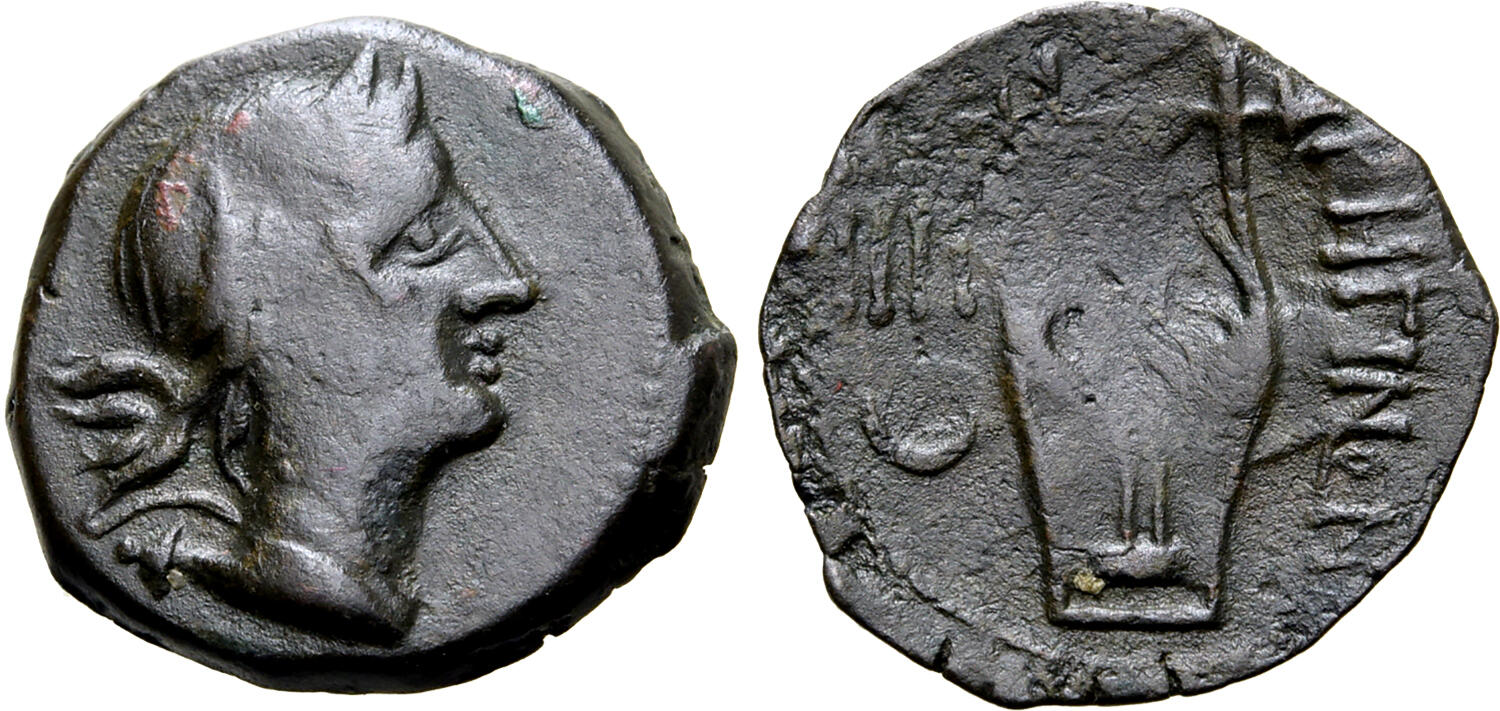210 BCE - 150 BCE | ΡΗΓΙΝΩΝ
Overstriking coin
SO 1421 - Rhegium (AE trias) over uncertain type.jpg
[1]
Overstruck variety
Rhegion_Apollo_Lyre.jpg
[2]
|
|
Sale(s)Sale(s) ᵖ:
|
Elsen, 35, 12 June 2010, 33
|
|
|
|
Description
| ObverseInscription or printing placed on the obverse.:
|
Jugate draped bust of the Dioskouroi right, wearing pilei. Border of dots.
|
ReverseInscription or printing placed on the reverse.:
|
ΡΗΓΙΝΩΝ (Greek) Asclepius facing, naked, holding scepter in left hand, a bird on right arm. In left field, IIII (value mark).
|
Mint and issuing power
| MintIdentifies the place of manufacture or issue of a numismatic object.:
|
Rhegium
|
Ancient regionAncient region.
|
Bruttium
|
Modern countryModern country: Italy
|
AuthorityIdentifies the issuing power. The authority can be "pretended" when the name or the portrait of X is on the coin but he/she was not the issuing power. It can also be "uncertain" when there is no mention of X on the coin but he/she was the issuing power according to the historical sources:
|
|
Chronology
| FromIdentifies the initial date in a range assigned in a numismatic context. 210 BCE toIdentifies the final date in a range assigned in a numismatic context.. 150 BCE
|
Hellenistic 323-30 BC  periodTime period of the numismatic object. periodTime period of the numismatic object.
|
Physical description
MetalThe physical material (usually metal) from which an object is made.: Bronze 
|
WeightWeight of the numismatic object (in grams). in grams: 3.183.18 g <br />3,180 mg <br />
|
DenominationTerm indicating the value of a numismatic object. Examples: tetradrachm, chalkous, denarius.: trias
|
|
|
|
|
References
Description
| ObverseInscription or printing placed on the obverse.:
|
|
ReverseInscription or printing placed on the reverse.:
|
ΡΗΓΙΝΩΝ downwards to right (Greek) Kithara, IIII (mark of value) and crescent to left
|
Mint and issuing power
| MintIdentifies the place of manufacture or issue of a numismatic object. ᵖ:
|
Rhegium
|
Ancient regionAncient region. ᵖ
|
Bruttium
|
Modern countryModern country: Italy
|
AuthorityIdentifies the authority in whose name (explicitly or implicitly) a numismatic object was issued. ᵖ:
|
|
Chronology
| FromIdentifies the initial date in a range assigned in a numismatic context. 211 BCE toIdentifies the final date in a range assigned in a numismatic context.. 200 BCE
|
Hellenistic 323-30 BC  periodTime period of the numismatic object. periodTime period of the numismatic object.
|
Physical description
| DenominationTerm indicating the value of a numismatic object. Examples: tetradrachm, chalkous, denarius. ᵖ:
|
trias
|
|
|
References
| Frequency of overstrikesFrequency of overstrikes:
|
rare and spread
|
Level of confidenceLevel of confidence of the identification:
|
sure
|
| RemarksRemarks:
|
"Surfrappé sur un bronze SNG ANS 763-765: au droit, on distingue le haut de la lyre du revers entre 4 et 6h; au revers, le profil d'Artémis à d., orienté 3h-9h"
|
References
- a b Troxell, Hyla A. (1975), Sylloge Nummorum Graecorum ANS 3. The Collection of the American Numismatic Society. Sicily 3 (Bruttium-Sicily I: Abacaenum-Eryx), New-York, pl. 38.
- a b Rutter N. Keith et alii (eds.) (2001), Historia Numorum Italy, London, xvi, 223 p., 43 pl.
- a b Hoover, Oliver D. (2018), The Handbook of Greek Coinage Series, Volume 1. Handbook of Coins of Italy and Magna Graecia, Sixth to First Centuries BC., Lancaster-London, 2018, lxi, 527 pages, 23 cm

